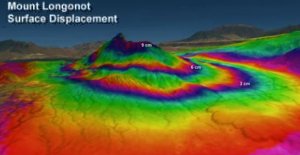
April Editorial
Satellite imagery can predict volcanic eruptions.

April Editorial
Satellite imagery can predict volcanic eruptions.
|
|
Volcano eruptions are notoriously difficult to predict. For many places, especially in developing countries, there can be no warning that an eruption is impending. Worldwide, only relatively few volcanoes are regularly monitored. But new studies from the University of Bristol, UK have shown that satellite imagery can tell if a particular volcano is uplifting. (A deformation of the surface of a volcano may well be caused by magma moving or pressurizing underground.) Archived satellite data of 500 volcanoes around the word were analyzed by a team consisting of Dr Juliet Biggs and colleagues at the School of Earth Sciences at Bristol University in collaboration with Dr Pritchard from Cornell University, New York, USA, Dr Lu from the Southern Methodist University in Texas and Dr Mather from the University of Oxford, UK. For 198 of those volcanoes multiple data sources were available spanning over 18 years. Analysis showed that the surface of 54 of those 198 volcanoes deformed during the 18 year period, and 24 of the 54 went on to erupt. Thus 48% of the volcanoes which uplifted then erupted. On the other hand 94% of the non-deforming volcanoes stayed quiescent. The numbers are not absolute, but they do indicate that a significant correlation between deformations and eruptions, and that these deformations are observable by satellite. Using additional short-term data (of a 3-year span) from 540 volcanoes, the scientists were able to show that the eruption–deformation pattern is influenced by tectonic, petrological and volcanic factors. Therefore the deformations may have different implications for different volcanoes. For volcanoes with short eruption cycles, the satellite records were sufficient to include both the deformation as well as eruption. However, for volcanoes with a long eruption cycles the satellite records captured either the deformation or the eruption. Details of individual regions and volcanoes used for this study can be found in the supplementary data (http://www.nature.com/ncomms/2014/140403/ncomms4471/extref/ncomms4471-s1.pdf ). The list of volcanoes was taken from the Global Volcanism Programme (GVP) (http://www.volcano.si.edu/index.cfm). The GVP is run by the Smithsonian Institute and is housed in the Department of Mineral Sciences in Washington DC. The main purpose of the GVP is to document, study and make publicly available information about global volcanic activity. The website contains a database with 7,000 reports on volcanic activity. It provides baseline data and the eruptive histories of the studied volcanoes. The group has also prepared a very interesting video summary of the deformations of some of the volcanoes which they studied. This can be viewed here: http://www.bristol.ac.uk/news/2014/april/volcano-deformation.html Putting the information together, Dr Biggs and her colleagues believe that satellite data can be successfully used as an indicator of a volcano's long-term eruptive potential. As the technology improves and more data becomes available, the accuracy of the predictions should also improve. In her own words: 'The findings suggest that satellite radar is the perfect tool to identify volcanic unrest on a regional or global scale and target ground-based monitoring.' This study is of particular relevance since on the 3rd of April 2014 the European Space Agency launched Sentinel-1 - a polar-orbiting, all-weather, day-and-night radar imaging mission for land and ocean services. This is the first in a series planned by the ESA. From now on satellites should provide systematic observations of the ups and downs of every volcano on the planet. Journal Reference: |
| _______________________________ | ||||
| Home | | | Shopping | | | Database |
© Biscuit Software 2004-2015
All rights reserved